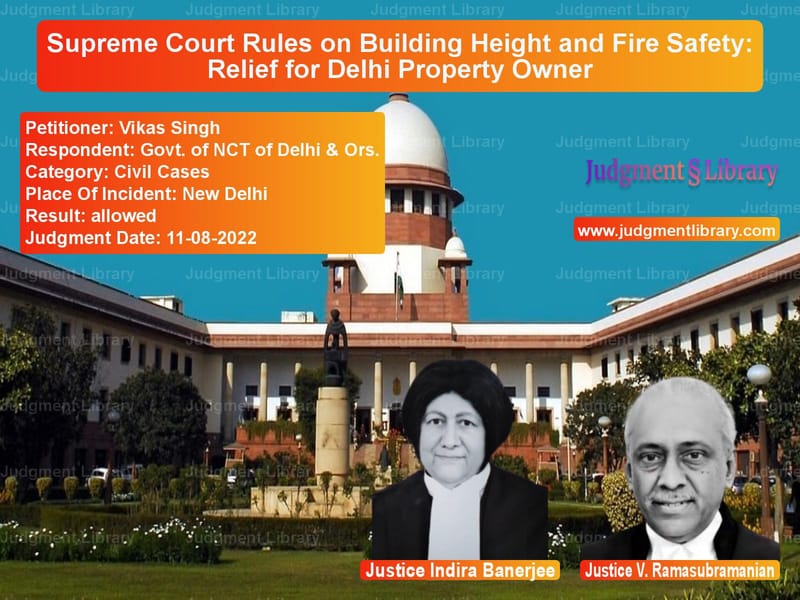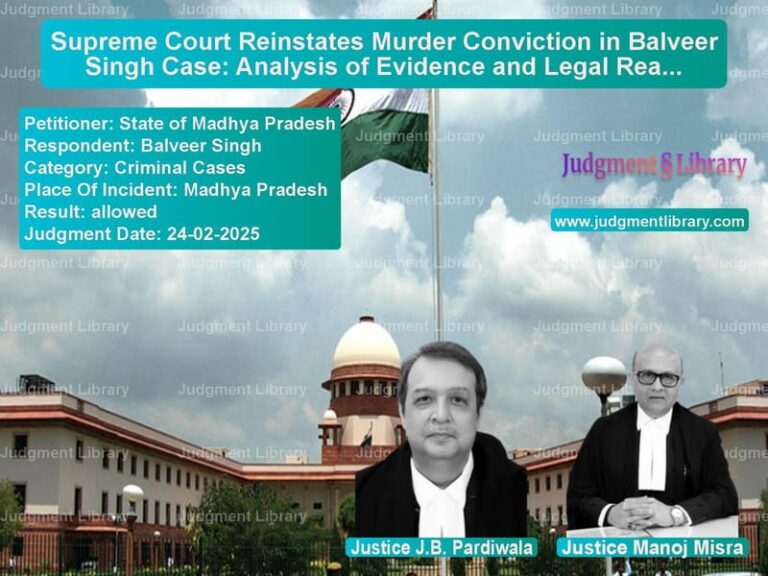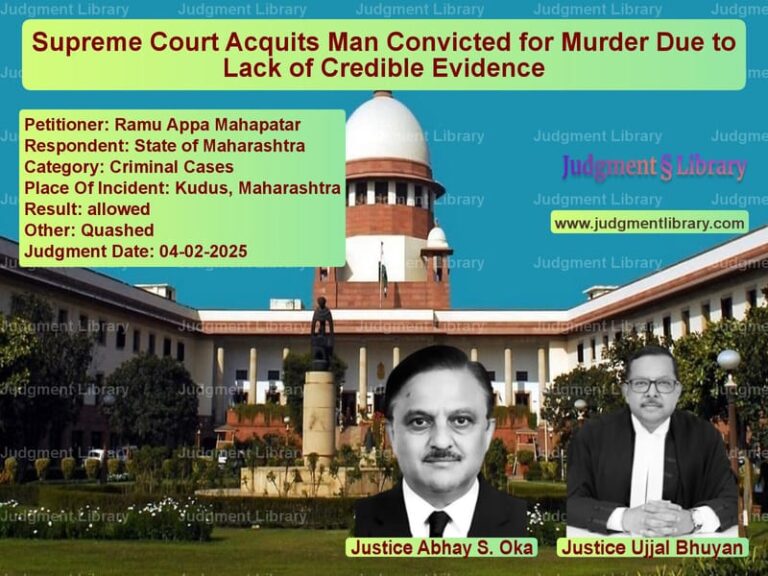Supreme Court Rules on Building Height and Fire Safety: Relief for Delhi Property Owner
The Supreme Court of India in Vikas Singh v. Govt. of NCT of Delhi & Ors. addressed a significant issue related to urban development, fire safety regulations, and building height restrictions. The case involved the refusal of the South Delhi Municipal Corporation (SDMC) to sanction a revised building plan for a residential property in Defence Colony, New Delhi, leading to a legal battle that culminated in a favorable ruling for the property owner.
Background of the Case
Vikas Singh, the appellant, purchased a property at C-319, Defence Colony, New Delhi, in 2013 with the intention of constructing a residential building. He initially obtained approval for his building plan from SDMC, which sanctioned a structure up to 15 meters in height, in compliance with the then-prevailing Building Bye-laws of 1983.
However, two months after receiving approval, the Ministry of Urban Development amended the Master Plan for Delhi in September 2013. The amendment allowed buildings with stilt parking to have a maximum height of 17.5 meters instead of 15 meters, provided they obtained clearance from the Fire Department. After learning of this change, Vikas Singh applied for a revised building plan to increase the height of his building to 16.6 meters, well within the revised limit of 17.5 meters.
Petitioner’s (Vikas Singh’s) Arguments
Vikas Singh challenged the refusal of his revised plan and sought relief from the Supreme Court on the following grounds:
- His building, even after the height increase, remained within the 17.5-meter limit prescribed under the amended Master Plan.
- SDMC and the Delhi Fire Service wrongly rejected his revised plan by misinterpreting fire safety norms.
- The refusal to approve his revised plan caused him severe financial hardship, as he had taken a bank loan of Rs. 20 crore and was paying Rs. 20 lakh in monthly installments.
- Fire clearance should not be required for his building, as it was below the stipulated high-rise category.
Respondents’ (Govt. of NCT of Delhi & SDMC’s) Arguments
The respondents opposed the petition with the following arguments:
- The amendment to the Master Plan did not explicitly clarify whether fire safety provisions should apply to buildings between 15 and 17.5 meters in height.
- Buildings above 15 meters pose greater fire hazards and require additional safety measures.
- The revised plan did not comply with the Delhi Fire Service Rules, which classified buildings above 15 meters as requiring additional fire safety clearances.
- Approval could not be granted unless the Fire Department certified compliance with fire safety requirements.
Supreme Court’s Key Observations
After reviewing the case, the Supreme Court made several crucial observations:
- The Master Plan for Delhi, as amended, explicitly allowed buildings up to 17.5 meters with stilt parking without classifying them as high-rise structures.
- The Unified Building Bye-laws required compliance with the Master Plan, and SDMC could not refuse approval based on outdated height restrictions.
- The requirement of fire safety clearance should apply only to high-rise buildings exceeding the prescribed height limits.
- Fire Department concerns about firefighting equipment inadequacies (such as the unavailability of ladders to reach buildings above 15 meters) could not justify denying approvals under legally approved guidelines.
Supreme Court’s Judgment
Based on these observations, the Supreme Court ruled in favor of Vikas Singh and issued the following directives:
- SDMC must reconsider and approve the revised building plan without unnecessary delays.
- Clearance from the Fire Department could be obtained, but it should not be a reason for rejection if the building complied with safety standards applicable to its category.
- The authorities could not impose high-rise building requirements on structures below 17.5 meters.
- Fire safety rules must be interpreted in conjunction with the Master Plan to avoid unnecessary hardship for property owners.
Impact of the Judgment
The ruling has significant implications for urban development and regulatory practices:
- Clarification on Building Height Regulations: The judgment establishes that buildings up to 17.5 meters with stilt parking should not be classified as high-rise structures.
- Relief for Property Owners: It prevents unnecessary hurdles for homeowners seeking to develop their properties in accordance with legally permitted guidelines.
- Fire Safety vs. Development Balance: The decision ensures that fire safety concerns do not become an arbitrary roadblock for construction approvals.
- Accountability for Authorities: SDMC and the Fire Department must adhere to established regulations rather than imposing discretionary restrictions.
Conclusion
The Supreme Court’s judgment in Vikas Singh v. Govt. of NCT of Delhi & Ors. is a landmark ruling that safeguards property rights while ensuring regulatory compliance. By upholding the provisions of the Master Plan and rejecting arbitrary interpretations of fire safety rules, the Court has reinforced the importance of fair governance in urban planning.
The case serves as a precedent for future disputes over building height regulations and the applicability of fire safety norms. It emphasizes the need for local bodies to align their approvals with statutory development plans, thereby preventing unnecessary litigation and financial hardships for property owners.
Petitioner Name: Vikas Singh.Respondent Name: Govt. of NCT of Delhi & Ors..Judgment By: Justice Indira Banerjee, Justice V. Ramasubramanian.Place Of Incident: New Delhi.Judgment Date: 11-08-2022.
Don’t miss out on the full details! Download the complete judgment in PDF format below and gain valuable insights instantly!
Download Judgment: vikas-singh-vs-govt.-of-nct-of-delh-supreme-court-of-india-judgment-dated-11-08-2022.pdf
Directly Download Judgment: Directly download this Judgment
See all petitions in Property Disputes
See all petitions in Contract Disputes
See all petitions in Damages and Compensation
See all petitions in Judgment by Indira Banerjee
See all petitions in Judgment by V. Ramasubramanian
See all petitions in allowed
See all petitions in supreme court of India judgments August 2022
See all petitions in 2022 judgments
See all posts in Civil Cases Category
See all allowed petitions in Civil Cases Category
See all Dismissed petitions in Civil Cases Category
See all partially allowed petitions in Civil Cases Category







